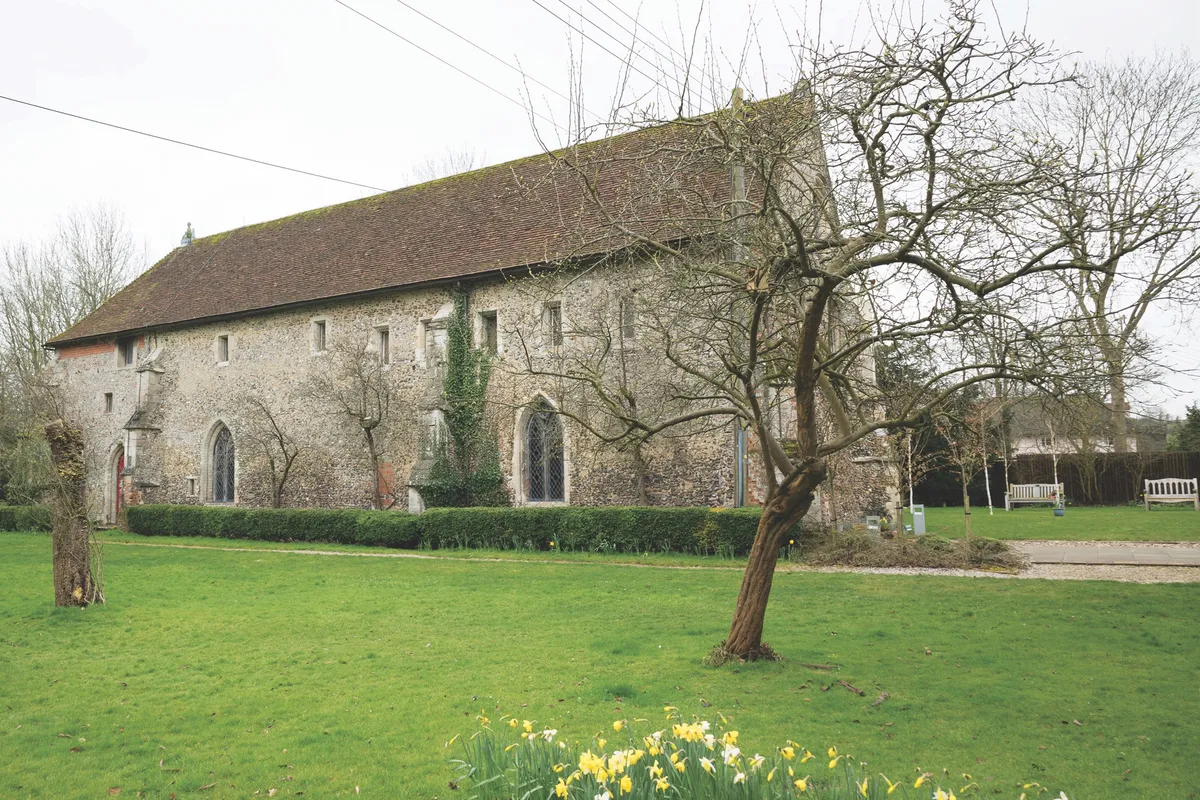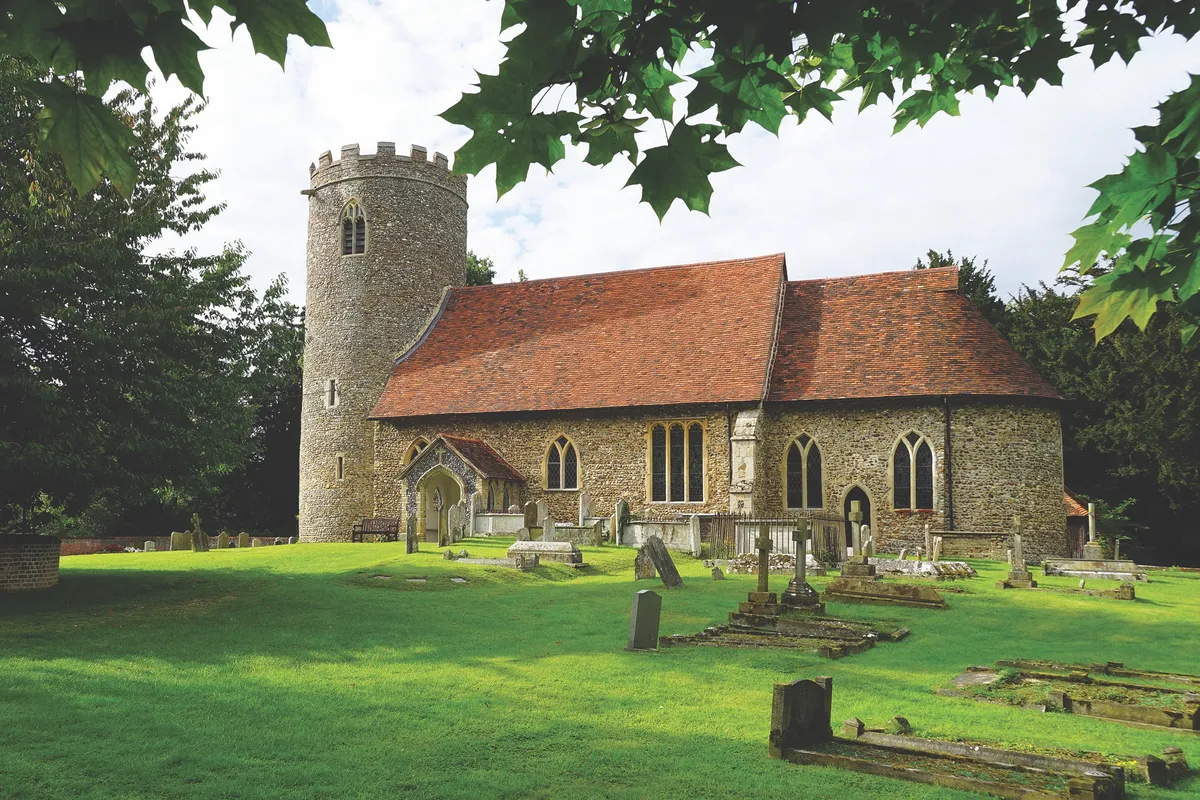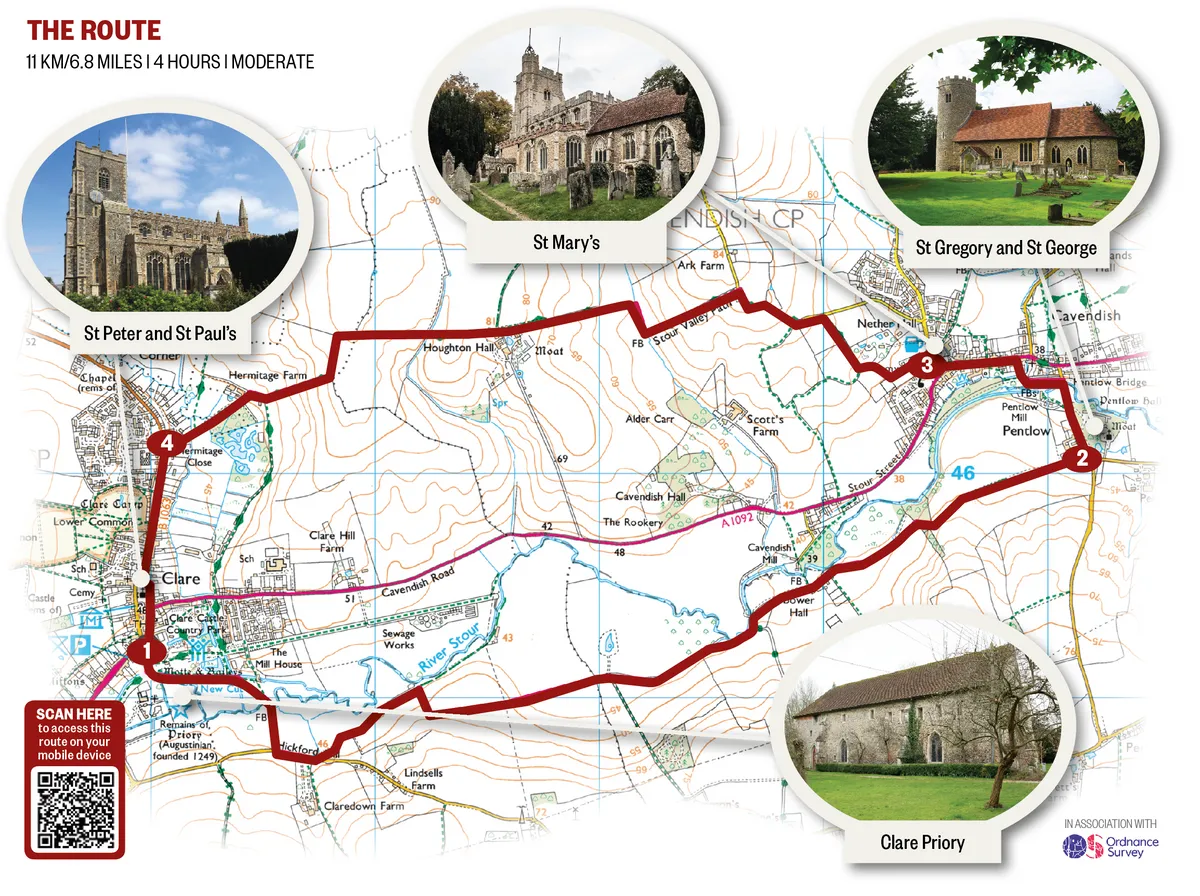The Stour Valley is gentle and undulating, an ever-changing patchwork of woodland trails and farmland fringed with sleeping hedgerows. Sprinkled with small towns and pretty bucolic villages of thatched painted cottages, and complete with a reassuring cluster of cosy tea rooms, this is an area to be savoured.
Starting from the historic wool town of Clare, Suffolk’s smallest town, the route links three of the area’s most charming churches, wending its way along the Stour Valley to Cavendish, before returning on the Stour Valley Path high above the river.

Pop into the St Gregory and St George church in Pentlow, with its distinctive round tower, visit a ghostly railway station and peaceful priory, and revel in some classic Suffolk views. The wind off the North Sea can come whistling down the valley, so wrap up warm and pack a thermos as you set off to explore this delightful Suffolk-Essex borderland.
Clare, Pentlow and Cavendish walk
6.9 miles/11.1km | 4 hours | moderate
1. Over the river
From Clare Castle Country Park car park, cross the metal bridge over the River Stour. The walk goes left here, but continue straight ahead for a detour to visit the charming 13th-century Clare Priory, one of the oldest religious houses in England and home to a mixed community of Augustinian friars and lay people. The priory is private but visitors are welcome in the peaceful grounds, ruins and shrine.

Return to the metal bridge and follow the riverbank to rejoin the route. Once over the weir, go diagonally right and continue up to the lane (you are now in Essex), turning left and joining the bridleway after about 200m.
When the track meets the meandering Stour river, turn right and follow the hedgerow east uphill for approximately 3km. Turn left at the lane, passing 16th-century Bower Hall. At the meadow, the path veers slightly right to follow the fenceline on through a wood to Pentlow (Essex).
2. Round tower
At the road, the route goes left but first, carry on ahead to the 12th-century church of St Gregory and St George with its unusual crenulated round tower. Take a peek behind the organ at the impressive 17th-century Kempe tomb, comprising recumbent figures of Judge George Kempe, his son John and daughter-in-law Elinore, and panel carvings of their 14 children.

Return to the road and cross the river back into Suffolk. Continue into Cavendish, turning left on to the riverbank footpath, with a fine row of poplar and weeping willows framing Pentlow Mill opposite. Look out for, then take the footpath on the right. Nip through a garden and along Ram Alley, turning left at Cavendish High Street, where cart wheels were once soaked in a pond – known as ‘The Waiver’ (meaning swampy ground) – to swell and tighten the wooden joints. In the 14th century, Cavendish was home to John Cavendish – the ancestor of the Dukes of Devonshire – whose son, also John, struck the fatal blow that killed Wat Tyler in the suppression of the Peasant’s Revolt in 1381.
3. Pretty in pink
Cross the busy road at The Green for one of Suffolk’s most iconic views and a quintessential English scene: a row of pink thatched cottages with a backdrop of St Mary the Virgin church. Unusually, the church tower has a chimney, which serves the fireplace in the priest’s room. Inside, note the striking 16th-century Flemish alabaster of the crucifixion, with gilded reredos and the poignant wooden crosses, 13 of them, each a temporary marker for parish residents who perished on the battlefields of the First World War. Look out, too, for the memorial to former residents, husband and wife Leonard Cheshire and Sue Ryder, both now known for their eponymous charities.

On departing, head along the back of The Green and pass the thatched Five Bells pub (something of a misnomer, for St Mary’s tower has six bells), soon joining the Stour Valley Path. This section (approximately 3.5km) crosses farmland with fine valley views, continues on by Houghton Hall and eventually drops down to Clare. At Hermitage Farm, take the path on the right through the farmyard and then left at the road.
4. Wool church
The final stretch winds through Clare, with its pretty historic buildings and independent shops. Pass to the right of St Peter and St Paul’s, one of the biggest wool churches in Suffolk, before stopping to visit the Ancient House Museum. The Grade-I-listed building, with its remarkable pargeting (decorative plastering), dates from the 14th century, making it one of the oldest houses in the county. Continue down Market Hill and, at the bottom, go left on to Station Road.

Enter Clare Castle Country Park and follow the path as it bends around to the right, back to the car park. Time permitting, climb the castle motte, dating to the time of William the Conqueror, for the best view of the town, and visit the old railway station (and café), both accessible from the car park. And If you’re looking for last-minute Christmas shopping, pop into the vast emporium of Clare Antiques in the old mill building.
For refreshments, there’s no shortage of choice: Café Clare on Well Lane and Platform One at the old railway station are two of our favourites. If all this leaves you wanting more, head for the annual Dickensian Christmas extravaganza (second and third weekends in December) at Tudor mansion Kentwell Hall, nearby in Long Melford.
Clare, Pentlow and Cavendish map
Clare, Pentlow and Cavendish walking route and map
